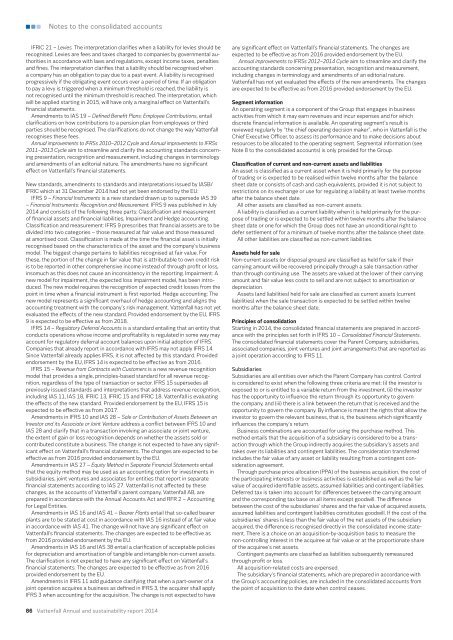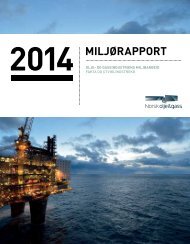annual-and-sustainability-report-2014
annual-and-sustainability-report-2014
annual-and-sustainability-report-2014
You also want an ePaper? Increase the reach of your titles
YUMPU automatically turns print PDFs into web optimized ePapers that Google loves.
Notes to the consolidated accountsIFRIC 21 – Levies. The interpretation clarifies when a liability for levies should berecognised. Levies are fees <strong>and</strong> taxes charged to companies by governmental authoritiesin accordance with laws <strong>and</strong> regulations, except income taxes, penalties<strong>and</strong> fines. The interpretation clarifies that a liability should be recognised whena company has an obligation to pay due to a past event. A liability is recognisedprogressively if the obligating event occurs over a period of time. If an obligationto pay a levy is triggered when a minimum threshold is reached, the liability isnot recognised until the minimum threshold is reached. The interpretation, whichwill be applied starting in 2015, will have only a marginal effect on Vattenfall’sfinancial statements.Amendments to IAS 19 – Defined Benefit Plans: Employee Contributions, entailclarifications on how contributions to a pension plan from employees or thirdparties should be recognised. The clarifications do not change the way Vattenfallrecognises these fees.Annual improvements to IFRSs 2010–2012 Cycle <strong>and</strong> Annual improvements to IFRSs2011–2013 Cycle aim to streamline <strong>and</strong> clarify the accounting st<strong>and</strong>ards concerningpresentation, recognition <strong>and</strong> measurement, including changes in terminology<strong>and</strong> amendments of an editorial nature. The amendments have no significanteffect on Vattenfall’s financial statements.New st<strong>and</strong>ards, amendments to st<strong>and</strong>ards <strong>and</strong> interpretations issued by IASB/IFRIC which at 31 December <strong>2014</strong> had not yet been endorsed by the EU:IFRS 9 – Financial Instruments is a new st<strong>and</strong>ard drawn up to supersede IAS 39– Financial Instruments: Recognition <strong>and</strong> Measurement. IFRS 9 was published in July<strong>2014</strong> <strong>and</strong> consists of the following three parts: Classification <strong>and</strong> measurementof financial assets <strong>and</strong> financial liabilities, Impairment <strong>and</strong> Hedge accounting.Classification <strong>and</strong> measurement: IFRS 9 prescribes that financial assets are to bedivided into two categories – those measured at fair value <strong>and</strong> those measuredat amortised cost. Classification is made at the time the financial asset is initiallyrecognised based on the characteristics of the asset <strong>and</strong> the company’s businessmodel. The biggest change pertains to liabilities recognised at fair value. Forthese, the portion of the change in fair value that is attributable to own credit riskis to be <strong>report</strong>ed in other comprehensive income instead of through profit or loss,insomuch as this does not cause an inconsistency in the <strong>report</strong>ing. Impairment: Anew model for impairment, the expected loss impairment model, has been introduced.The new model requires the recognition of expected credit losses from thepoint in time when a financial instrument is first <strong>report</strong>ed. Hedge accounting: Thenew model represents a significant overhaul of hedge accounting <strong>and</strong> aligns theaccounting treatment with the company’s risk management. Vattenfall has not yetevaluated the effects of the new st<strong>and</strong>ard. Provided endorsement by the EU, IFRS9 is expected to be effective as from 2018.IFRS 14 – Regulatory Deferral Accounts is a st<strong>and</strong>ard entailing that an entity thatconducts operations whose income <strong>and</strong> profitability is regulated in some way mayaccount for regulatory deferral account balances upon initial adoption of IFRS.Companies that already <strong>report</strong> in accordance with IFRS may not apply IFRS 14.Since Vattenfall already applies IFRS, it is not affected by this st<strong>and</strong>ard. Providedendorsement by the EU, IFRS 14 is expected to be effective as from 2016.IFRS 15 – Revenue from Contracts with Customers is a new revenue recognitionmodel that provides a single, principles-based st<strong>and</strong>ard for all revenue recognition,regardless of the type of transaction or sector. IFRS 15 supersedes allpreviously issued st<strong>and</strong>ards <strong>and</strong> interpretations that address revenue recognition,including IAS 11, IAS 18, IFRIC 13, IFRIC 15 <strong>and</strong> IFRIC 18. Vattenfall is evaluatingthe effects of the new st<strong>and</strong>ard. Provided endorsement by the EU, IFRS 15 isexpected to be effective as from 2017.Amendments in IFRS 10 <strong>and</strong> IAS 28 – Sale or Contribution of Assets Between anInvestor <strong>and</strong> its Associate or Joint Venture address a conflict between IFRS 10 <strong>and</strong>IAS 28 <strong>and</strong> clarify that in a transaction involving an associate or joint venture,the extent of gain or loss recognition depends on whether the assets sold orcontributed constitute a business. The change is not expected to have any significanteffect on Vattenfall’s financial statements. The changes are expected to beeffective as from 2016 provided endorsement by the EU.Amendments in IAS 27 – Equity Method in Separate Financial Statements entailthat the equity method may be used as an accounting option for investments insubsidiaries, joint ventures <strong>and</strong> associates for entities that <strong>report</strong> in separatefinancial statements according to IAS 27. Vattenfall is not affected by thesechanges, as the accounts of Vattenfall’s parent company, Vattenfall AB, areprepared in accordance with the Annual Accounts Act <strong>and</strong> RFR 2 – Accountingfor Legal Entities.Amendments in IAS 16 <strong>and</strong> IAS 41 – Bearer Plants entail that so-called bearerplants are to be stated at cost in accordance with IAS 16 instead of at fair valuein accordance with IAS 41. The change will not have any significant effect onVattenfall’s financial statements. The changes are expected to be effective asfrom 2016 provided endorsement by the EU.Amendments in IAS 16 <strong>and</strong> IAS 38 entail a clarification of acceptable policiesfor depreciation <strong>and</strong> amortisation of tangible <strong>and</strong> intangible non-current assets.The clarification is not expected to have any significant effect on Vattenfall’sfinancial statements. The changes are expected to be effective as from 2016provided endorsement by the EU.Amendments in IFRS 11 add guidance clarifying that when a part-owner of ajoint operation acquires a business as defined in IFRS 3, the acquirer shall applyIFRS 3 when accounting for the acquisition. The change is not expected to haveany significant effect on Vattenfall’s financial statements. The changes areexpected to be effective as from 2016 provided endorsement by the EU.Annual improvements to IFRSs 2012–<strong>2014</strong> Cycle aim to streamline <strong>and</strong> clarify theaccounting st<strong>and</strong>ards concerning presentation, recognition <strong>and</strong> measurement,including changes in terminology <strong>and</strong> amendments of an editorial nature.Vattenfall has not yet evaluated the effects of the new amendments. The changesare expected to be effective as from 2016 provided endorsement by the EU.Segment informationAn operating segment is a component of the Group that engages in businessactivities from which it may earn revenues <strong>and</strong> incur expenses <strong>and</strong> for whichdiscrete financial information is available. An operating segment’s result isreviewed regularly by “the chief operating decision maker”, who in Vattenfall is theChief Executive Officer, to assess its performance <strong>and</strong> to make decisions aboutresources to be allocated to the operating segment. Segmental information (seeNote 8 to the consolidated accounts) is only provided for the Group.Classification of current <strong>and</strong> non-current assets <strong>and</strong> liabilitiesAn asset is classified as a current asset when it is held primarily for the purposeof trading or is expected to be realised within twelve months after the balancesheet date or consists of cash <strong>and</strong> cash equivalents, provided it is not subject torestrictions on its exchange or use for regulating a liability at least twelve monthsafter the balance sheet date.All other assets are classified as non-current assets.A liability is classified as a current liability when it is held primarily for the purposeof trading or is expected to be settled within twelve months after the balancesheet date or one for which the Group does not have an unconditional right todefer settlement of for a minimum of twelve months after the balance sheet date.All other liabilities are classified as non-current liabilities.Assets held for saleNon-current assets (or disposal groups) are classified as held for sale if theircarrying amount will be recovered principally through a sale transaction ratherthan through continuing use. The assets are valued at the lower of their carryingamount <strong>and</strong> fair value less costs to sell <strong>and</strong> are not subject to amortisation ordepreciation.Assets (<strong>and</strong> liabilities) held for sale are classified as current assets (currentliabilities) when the sale transaction is expected to be settled within twelvemonths after the balance sheet date.Principles of consolidationStarting in <strong>2014</strong>, the consolidated financial statements are prepared in accordancewith the principles set forth in IFRS 10 – Consolidated Financial Statements.The consolidated financial statements cover the Parent Company, subsidiaries,associated companies, joint ventures <strong>and</strong> joint arrangements that are <strong>report</strong>ed asa joint operation according to IFRS 11.SubsidiariesSubsidiaries are all entities over which the Parent Company has control. Controlis considered to exist when the following three criteria are met: (i) the investor isexposed to or is entitled to a variable return from the investment, (ii) the investorhas the opportunity to influence the return through its opportunity to governthe company, <strong>and</strong> (iii) there is a link between the return that is received <strong>and</strong> theopportunity to govern the company. By influence is meant the rights that allow theinvestor to govern the relevant business, that is, the business which significantlyinfluences the company’s return.Business combinations are accounted for using the purchase method. Thismethod entails that the acquisition of a subsidiary is considered to be a transactionthrough which the Group indirectly acquires the subsidiary’s assets <strong>and</strong>takes over its liabilities <strong>and</strong> contingent liabilities. The consideration transferredincludes the fair value of any asset or liability resulting from a contingent considerationagreement.Through purchase price allocation (PPA) of the business acquisition, the cost ofthe participating interests or business activities is established as well as the fairvalue of acquired identifiable assets, assumed liabilities <strong>and</strong> contingent liabilities.Deferred tax is taken into account for differences between the carrying amount<strong>and</strong> the corresponding tax base on all items except goodwill. The differencebetween the cost of the subsidiaries’ shares <strong>and</strong> the fair value of acquired assets,assumed liabilities <strong>and</strong> contingent liabilities constitutes goodwill. If the cost of thesubsidiaries’ shares is less than the fair value of the net assets of the subsidiaryacquired, the difference is recognised directly in the consolidated income statement.There is a choice on an acquisition-by-acquisition basis to measure thenon-controlling interest in the acquiree at fair value or at the proportionate shareof the acquiree’s net assets.Contingent payments are classified as liabilities subsequently remeasuredthrough profit or loss.All acquisition-related costs are expensed.The subsidiary’s financial statements, which are prepared in accordance withthe Group’s accounting policies, are included in the consolidated accounts fromthe point of acquisition to the date when control ceases.86 Vattenfall Annual <strong>and</strong> <strong>sustainability</strong> <strong>report</strong> <strong>2014</strong>



